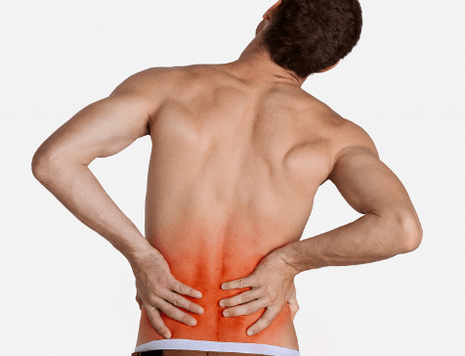Lumbar osteochondrosis is a deformity of the spine in the lumbar region.The disease affects the intervertebral discs, cartilage tissue, spinal roots and nerve fibers and causes back pain.
Reason

The main cause of the disease is the improper distribution of load on the muscular system.Usually this happens when you walk on high heels, wearing a bag on one side, with an unpleasant position in a dream or in a sitting job.Elderly people, pregnant professionals, born alone, professionals and office staff are at risk.
Other causes of lumbar osteochondrosis:
- injuries, bruises, fractures of weapons, legs, spine;
- damage to the organs of the musculoskeletal system;
- Gastrointestinal diseases that provoke a lack of useful substances;
- body tension in extended loads;
- psycho -emotional disorders;
- violations of blood flow to the spinal column;
- inflammation of the musculoskeletal apparatus;
- infections of the internal organs and vertebrae;
- stiffness of the joints, displacement of the disc;
- Prolonged and interstitial hernia;
- severe intoxication;
- metabolic disorders;
- bending of behavior;
- sedentary lifestyle;
- dehydration;
- unbalanced diet;
- Lack of calcium and oxygen;
- Excess weight;
- bad habits;
- age -related changes;
- Common diseases.
Symptoms of lumbar osteochondrosis
The intensity and nature of the symptoms depends on the stage of the disease.The sooner the patient finds signs of lumbosacral osteochondrosis, the more effective the treatment will be.
General symptoms:
- severe pain at the bottom of the back, which can give the legs, internal organs of the abdomen and pelvis;
- kidney pain and sacrum;
- fatigue and stress in the lower back and sacral spine;
- difficulty in motion, walking, inclination and curves of the body;
- Periodic background in the back;
- Fatigue after small load;
- cramping on the back, violation of mobility, pain in a calm state;
- numbness of the limbs;
- spasms and cramps in the muscles;
- dizziness;
- weakness and loss of force;
- Reduction of muscle tone and sensitivity.
In men and women, manifestations of lumbar osteochondrosis can vary.Men can have problems with power.Women often suffer from pelvis pain.When a deformed spine cannot fully support the back, the uterus and supplements experience additional loads, and sometimes move for a normal physiological position.
varieties
The classification of lumbar back osteochondrosis consists of several types of disease.By the type of pain syndrome, they distinguish:
Lumbago.Acute symptom.It is expressed with sharp bastards and inability to move.It occurs with muscle cramps, injuries, pinches of discs and nerve roots.
Lumbalgia.It is characterized by long -term painful pain caused by hernia, protrusions, spondylarthrosses, ligaments and other disorders of the muscular system.
Çatika.Powerful pain syndrome in the Lumbosakral department, Eradiri in the pond.The pain applies to the sciatica, prevents curvature and normal body extension, prevents me from sitting and staying painlessly.
Osteochondrosis and discogenic lumbar radiculopathy are also distinguished.
Osteochondrosis of discogue lumbarIt is associated with a loss of sensitivity and numbness not only of the sore back but also the legs, buttocks, buttocks and the end of the abdomen.Sometimes body temperature rises, weakness, urinary incontinence, the patient loses weight.
Radiculopathyexpressed by numbness of nerve roots and a decrease in human motor skills.Signs - the sensitive time or pain of the whole lower body, damaged reflexes, lowering muscle tone and limb joints.
Stages of development of lumbar osteochondrosis
Doctors trace the dynamics of pathology in four stages:
- First.The symptoms are almost invisible - they are diagnosed in an X -ray.The phase begins with the pathological processes in the cavity for the purpose of the disk over the fibrous ring.
- Second.The height of the intervertebral discs is reduced, which makes vertebrae located closely.This causes the vertebrae to slide and displace, which is associated with pain during movements.
- Third.It is characterized by stiffness, instability, numbness of the body in coccyx, lower spine and sacrum.This can be explained by prolonged vertebrae, proportions, joint displacements and arthrosis in the back.
- Fourth.The most severe rate.The functions of the spinal column are damaged in it and bone growth (osteophytes) is formed.Growals can lead the nerves or damage the integrity of the vertebrae.
The consequences of Lumbari's osteochondrosis
- Excessive salt accumulation in the body;
- The development of hernia, extension, prolope of vertebrae and discs;
- Chronic radiculitis;
- Paresis and paralysis of the feet.
Troubleshooting
Lumbar osteochondrosis and other disorders of the skeletal muscle system can diagnose orthopedist, osteopathy, neurologist, rheumatologist, manual therapist and surgeon.POSSIBLEST Possible to make an accurate diagnosis after:
- X -Ray of the spinal column, which indicates the condition of bone, cartilage and muscle tissue, as well as ligaments and tendons.
- Myelography - studies of cerebrospinal fluid with paint.With its help, the nerve roots of the spinal cord are studied and appreciated.
For a more detailed examination, doctors use CT and MRI.You may undergo diagnostics in the clinic.

























